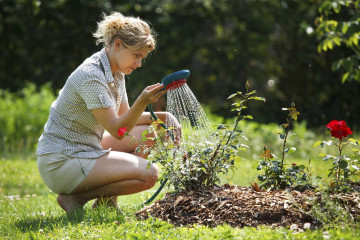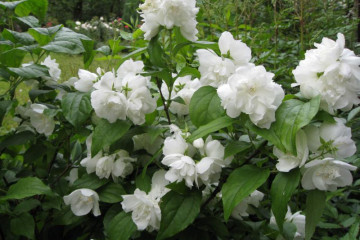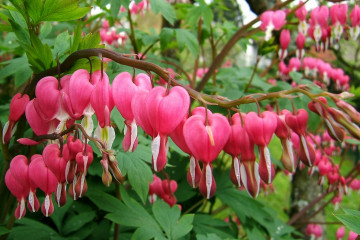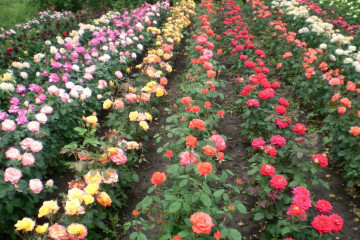Canadian roses - the best varieties, planting and care in the open field
Content: [Hide]
Roses can make any bouquet truly royal. Unfortunately, these flowers are often very capricious and do not tolerate cold weather. At least that's what is commonly believed. But the truth is that a lot depends on the species - modern Canadian roses are able to withstand even severe frosts. In addition, this plant rarely infects viral and fungal diseases. Representatives of the variety can hibernate without shelter.
Features of the variety
Experienced growers know that caring for ornamental plants takes a lot of time and effort. In addition, not all flowers are able to survive in harsh climates. Canadian breeders have developed varieties of roses that are resistant not only to cold weather, but also to powdery mildew. Here are their main advantages:
- long flowering period;
- pleasant, but unobtrusive aroma;
- the ability to reproduce by cuttings;
- no difficulties in leaving;
- the ability to plant outdoors, even in cold regions;
- well suited for creating a hedge.
In addition, the Canadian rose does not require additional shelter during the cold season. The flower has a double or semi-double texture. There are buds of white, pink, red, cream and salmon shades.
Saplings feel great even in northern latitudes. These flowers can beautify any garden.
Frost resistance
The Canadian rose, as a rule, looks more modest than other varieties, but is able to withstand even a 30-degree frost. This flower doesn't really require a spunbond or spruce tree cover. The flowering period begins from the first days of summer, and ends with the onset of the first frosts.
In the first winter, for safety reasons, it is necessary to spud the base of the bush with sand and earth in equal parts.
Lush bloom
Roses of Canadian selection are resistant to weather changes. They are able to bloom magnificently all summer. The leaves of the plant are rich green. The variety of shades and the small number of thorns made these varieties popular among florists and decorators. Flowering can continue until frost. Its beginning depends on the region.
Recovery after frost
Breeders from Canada have worked for a long time to develop roses that can withstand extreme cold. As a result, scientists have discovered flowers with excellent regenerative properties. Rapid recovery after cold weather is inherent in the genotype of the plant. In case of complete freezing of the crown, the twigs can grow back from the renewal buds on the roots.
Disease resistance
Roses of Canadian selection are an excellent solution for novice gardeners and those who do not want to spend a lot of time caring for a flower bed. This unpretentious plant is famous for its increased disease resistance.
Certain varieties of Canadian roses often infest pests, most often the green rose aphid. For prevention purposes, you need to treat the plant with systemic or contact insecticides.
Growing Canadian roses
In the spring, it is advisable to perform a small sanitary pruning and feed the plant with mineral or organic fertilizers. Planting hedges is best done in the spring or fall. Three-year-old seedlings are suitable for this purpose.
Landing
The unpretentious Canadian rose loves the sunny side, but takes root well in partial shade. It is recommended to fill the planting hole with a depth of 70 cm with light fertile soil.
Top dressing
In order to achieve lush flowering, nitrogen fertilizers can be applied in the spring, and in July it is useful to feed the plant with phosphorus or potassium.
Watering
You need to water the plant from the first warm spring days until the end of summer. Water should not come into contact with flowers and leaves. It is enough to water a frost-resistant rose 2-3 times a week.
Pruning
It is necessary to prune the bushes annually. After the flowering period, those branches that did not give buds are recommended to be removed.
In the spring, before the buds bloom, you need to cut off the weak and frozen internal shoots. In order for the flowering to be continuous, horticultural experts advise to regularly remove wilted inflorescences.
Reproduction by layering
Canadian non-covering roses are propagated using cuttings. In the middle of summer, healthy and young shoots are cut from an adult mother plant. The seedlings must be dug into the ground immediately. This is necessary in order not to damage the root branches. For the first winter, young plants must be covered with earth.
A month before planting, the land must be weeded. Cover the cuttings with halves of plastic bottles. This shelter must be removed after the snow melts.
The best varieties and their characteristics
Hardy Canadian roses are difficult to classify. Various hybrid forms were used to breed them.
Winter-hardy roses are well suited for planting in round and oval flower beds. The bushes of the plant are used as a background for a mixborder. Most often, hybrids of wrinkled roses and modern varieties are used for this purpose.
Representatives of the park group have an exquisite shape and bright colors. True, the aroma of these flowers is barely perceptible. Climbing roses are found in the Explorer group. The buds have a rich aroma. The Canadian climbing rose was bred using Cordes hybrids.
Prairie Joy
Prairie Joy roses grow up to 150 cm in length. The buds are deep pink. This winter-hardy variety is well suited for growing in a flowerbed or in the country, and can also be used as a living fence.
Rose Canadian century-old Prairie Joy tolerates partial shade and poor soil well. This plant has a small number of thorns.
Frontenac
This rose has a dense and branched bush. The flowers are dark pink or light crimson. This rose variety is a good choice for landscaping. The buds are cupped. In the northern regions, without shelter, it can freeze out to the level of snow, but it grows quickly and recovers.
William Buffin Climbing
The Canadian climbing rose is easily propagated by cuttings and is resistant to disease. The foliage of the plant is dark with a slight sheen. Flowers about 7 cm in size appear in large clusters of 10-30 pieces. The buds are bright pink with yellow stamens. Bulky bushes can be up to 2 meters wide. The flowering period ends in late autumn.
Cuthbert Grant
This variety prefers a sunny location. Cup-shaped flowers appear in clusters of 3-9 pieces. These roses have a light aroma. Bushes Cuthbert Grant are not demanding on the soil, but with regular feeding they will bloom better.
The main difference between this variety is its increased winter hardiness. This plant has flowers of a noble purple color, which is harmoniously combined with gray-green foliage.
Martin Frobisher
This Canadian park rose is very easy to care for. The bushes grow quickly and can form the basis for compositions with other flowers.
Horticultural beginners are looking for a variety that won't be a hassle. Martin Frobisher would be the right choice. There are no thorns on young shoots, so the flower is great for creating bouquets. Martin buds are usually pale pink in color.
Champlain
Flowers are collected in small clusters of 5-7 pieces. Champlain roses are capable of blooming until the very frost. This flower will illuminate the flower bed with bright colors.
The foliage is small and shiny. The variety is one of the strongest flowering varieties. Recommended for planting on the sunny side. Champlain are resistant to plant diseases, but are sometimes affected by powdery mildew.
Canadian bushy unpretentious rose of this variety blooms continuously until the very cold.
Growing problems and mistakes
Growing roses in cold climates has always been considered risky and challenging. Fortunately, frost-resistant modern varieties have appeared. However, there are some rules that will help you successfully grow a Canadian cold-resistant uncovering rose:
- watering the plant is best during the period of active vegetative growth;
- it is recommended to fertilize bushes from the second year of the seedling's life;
- it is advisable to cover young plants in cold winter with spruce branches;
- it is important that the soil is loose;
- if the soil is clay, before planting the plant, add humus or sand to the hole.
These tips will help you successfully grow frost-resistant roses on the site.
Roses of Canadian selection are unpretentious and resistant to severe weather conditions. Such flowers can be grown even in the northern regions of Russia. They perfectly tolerate not only frost, but also summer heat. This plant is very easy to care for.
























